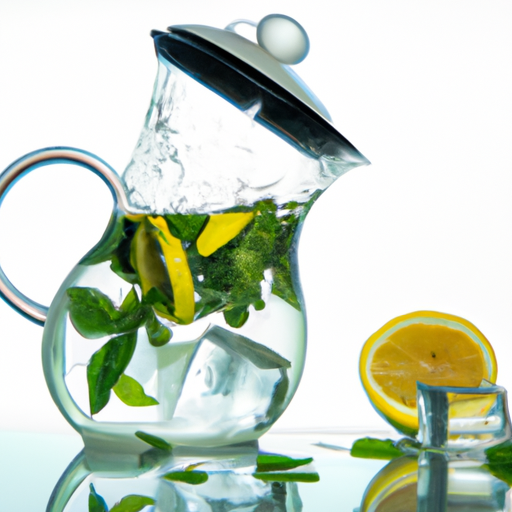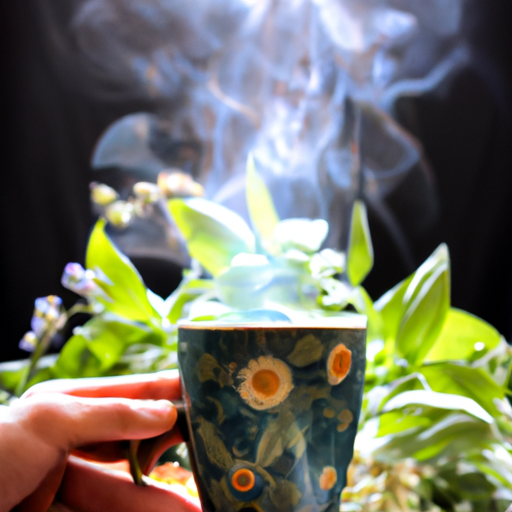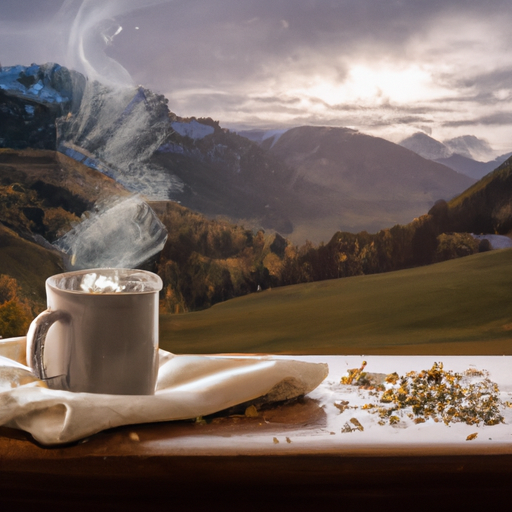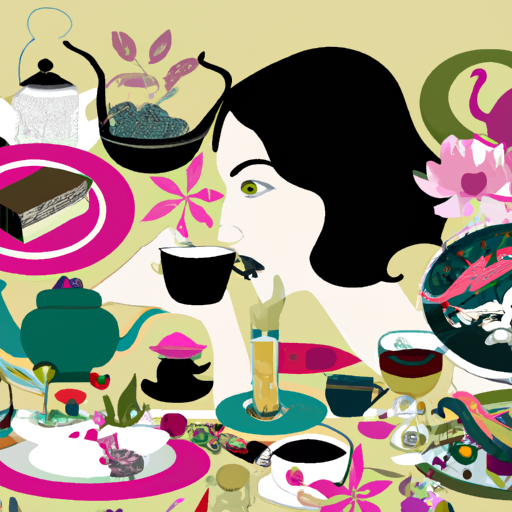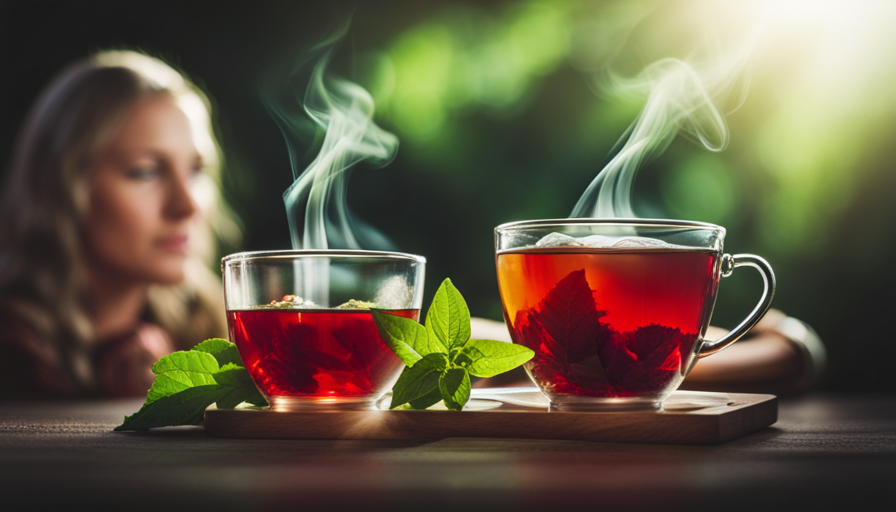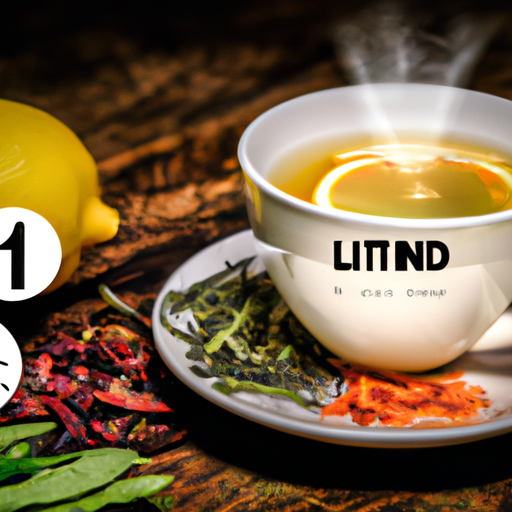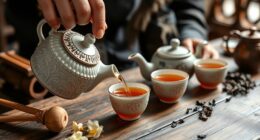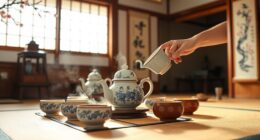Do you feel bored with your usual hot drinks? Are you searching for a rejuvenating and nutritious option? Search no more! I am excited to reveal to you a secret that will excite your taste buds and awaken your senses.
Imagine a cool, crisp drink that not only quenches your thirst but also provides numerous health benefits. That’s right, I’m talking about cold herbal tea brews!
In this article, I will guide you through the step-by-step process of creating your very own cold herbal tea, bursting with flavor and goodness. From selecting the perfect herbal blend to infusing it with fruity and citrus flavors, I will show you how to create a brew that will leave you feeling refreshed and revitalized.
So, grab your favorite herbal tea blend and let’s embark on this exciting journey together. Get ready to discover the art of making a cold herbal tea brew that will not only tantalize your taste buds but also nourish your body from within.
Let’s dive in and uncover the secrets behind this delightful and healthy beverage!
Key Takeaways
- Cold herbal tea is a refreshing and healthy alternative to hot beverages.
- Cold brewing herbal tea preserves delicate flavors and reduces bitterness.
- Organic herbs and fruits should be used for the best flavor and health benefits.
- Adding fruits, herbs, and spices can create unique flavor combinations in cold herbal tea.
Choose Your Favorite Herbal Tea Blend
Now it’s time to choose your favorite herbal tea blend and let the flavors dance in your cup! Choosing the right blend is essential for a delicious and refreshing cold herbal tea brew.
With so many options available, you have the opportunity to explore unique flavors and find the perfect blend that suits your taste buds.
When selecting your herbal tea blend, consider the flavors you enjoy the most. Are you a fan of fruity teas? Or do you prefer more earthy and floral notes? Some popular options include chamomile, peppermint, hibiscus, and lavender. Each of these blends offers its own distinct flavor profile, so take the time to experiment and discover your favorite.
It’s important to note that not all herbal teas are suitable for cold brewing. Some blends may become too bitter or lose their flavor when brewed with cold water. To ensure the best results, look for teas specifically labeled for cold brewing. These blends are designed to release their flavors slowly in cold water, resulting in a refreshing and flavorful brew.
Now that you have chosen your favorite herbal tea blend, it’s time to gather your ingredients and equipment needed for the cold brewing process.
Gather Your Ingredients and Equipment
First, you’ll need to gather all the necessary ingredients and equipment for creating a refreshing, revitalizing infusion. Choosing the right equipment is crucial to ensuring a successful cold herbal tea brew. You will need a large glass pitcher or a mason jar with a lid, as well as a fine mesh strainer or cheesecloth to strain the tea leaves later.
Using fresh ingredients is key to achieving the best flavor and health benefits. Opt for organic herbs and fruits if possible, as they’re free from pesticides and chemicals. Some popular options for cold herbal teas include mint, chamomile, hibiscus, and green tea.
To prepare your tea infusion, start by washing and chopping any fruits or herbs you’ll be using. This’ll help release the flavors more effectively. Next, place the ingredients into the glass pitcher or mason jar, making sure to use the recommended amount for each herb or fruit. Fill the container with cold, filtered water, leaving some space at the top for expansion. Gently stir the mixture, ensuring all the ingredients are submerged.
Cover the container and refrigerate for at least 4 hours or overnight to allow the flavors to infuse. Once the infusion’s complete, you can strain the tea into individual glasses or bottles, and enjoy the refreshing, homemade cold herbal tea.
Prepare Your Tea Infusion
When it comes to preparing a tea infusion, there are a few key points to consider. First, you need to decide whether you want to use a boiling or steeping method. Boiling extracts more flavor and can create a stronger brew, while steeping is gentler and more delicate.
Next, you can adjust the brew strength and steeping time to suit your taste preferences. Finally, cold infusion techniques are another option to explore, which can result in a refreshing and light tea.
Boiling vs. Steeping Methods
To create a refreshing herbal tea brew, it’s best to opt for the boiling method rather than steeping. Boiling techniques allow for a more robust extraction of flavors and nutrients from the herbs.
Here are some key points to consider:
- Boiling temperature: Boil the water at 212°F (100°C) to ensure proper extraction.
- Time: Let the tea simmer for about 10-15 minutes to release the full potential of the herbs.
- Agitation: Stir the tea occasionally during boiling to enhance flavor dispersion.
- Straining: Once the tea is boiled, strain it to remove any herb particles and achieve a smooth brew.
- Cooling: Allow the tea to cool before refrigerating to avoid temperature shock.
By employing the boiling method, you’ll have a potent and flavorful herbal tea brew ready to be enjoyed.
Now, let’s delve into adjusting brew strength and steeping time for further customization.
Adjusting Brew Strength and Steeping Time
For a truly mind-blowing infusion, you’ll want to unleash your inner alchemist and experiment with different steeping times and brew strengths. Adjusting brew strength and steeping time techniques can make a world of difference in the flavor and potency of your cold herbal tea.
To increase the brew strength, simply add more tea leaves or herbs to the water. For a lighter brew, reduce the amount of tea used. Steeping time also plays a crucial role in the final outcome. Longer steeping times will result in a stronger, more intense flavor, while shorter steeping times will produce a milder taste.
It’s important to note that each herb or tea variety may require different steeping times and brew strengths, so don’t be afraid to experiment. Now, let’s delve into the exciting world of cold infusion techniques.
Cold Infusion Techniques
Discover the secrets of creating incredible flavors with these cold infusion techniques that’ll leave your taste buds begging for more.
Cold infusion techniques are a great way to make a refreshing and flavorful herbal tea brew. The benefits of cold brewing herbal tea are numerous. Firstly, it preserves the delicate flavors and aromas of the herbs, resulting in a smoother and more balanced taste. Secondly, it reduces the bitterness and astringency that can sometimes occur when using hot water.
To cold infuse, simply place your desired herbs in a pitcher of cold water and let it steep in the refrigerator for several hours or overnight. The longer you steep, the stronger the flavor will be.
Once your cold infusion is ready, you can enhance your brew with fruity or citrus flavors by adding slices of fresh fruit or a squeeze of lemon or lime. This’ll add a burst of brightness and complexity to your herbal tea brew, taking it to the next level of deliciousness.
So why wait? Start experimenting with cold infusion techniques and elevate your herbal tea experience today.
Enhance Your Brew with Fruity or Citrus Flavors
Indulge your taste buds in a refreshing symphony of flavors by infusing your cold herbal tea brew with the vibrant essence of juicy fruits or tangy citrus. Adding fruity infusions or a citrus twist to your herbal tea can elevate its taste and create a delightful drinking experience. Here are four ways to enhance your brew with fruity or citrus flavors:
-
Fresh Fruits: Chop up your favorite fruits like strawberries, peaches, or watermelon, and add them to your tea. Let the flavors meld together in the refrigerator for a few hours before straining and serving.
-
Citrus Zest: Grate the zest of lemons, limes, or oranges and sprinkle it into your tea. The citrus oils will infuse the brew with a bright and zesty aroma.
-
Fruit Juices: Mix fruit juices like pineapple, mango, or cranberry with your herbal tea. This will add a burst of sweetness and depth to your cold brew.
-
Citrus Slices: Thinly slice lemons, limes, or oranges and add them directly to your tea. The slices will release their tangy flavors as they steep in the brew.
By incorporating these fruity infusions and citrus twists, you can create a delicious and refreshing cold herbal tea brew. Experiment with flavorful additions to further enhance your tea-drinking experience.
Experiment with Flavorful Additions
Enhancing your brew with flavorful additions opens up a world of possibilities for a truly unique and satisfying tea experience. When it comes to cold herbal tea, there are endless options to explore.
One way to add extra depth and complexity to your brew is by incorporating floral infusions. Adding dried flowers like lavender, chamomile, or rose petals can infuse your tea with delicate floral notes that complement the herbal flavors.
You can also experiment with unique flavor combinations by adding fruits, herbs, or spices. For a refreshing twist, try adding slices of fresh cucumber or a sprig of mint to your tea. The coolness of the cucumber pairs perfectly with the herbal flavors, while the mint adds a refreshing and invigorating touch.
Another option is to infuse your tea with slices of citrus fruits like lemon, lime, or orange. The citrusy flavors will brighten up your brew and add a zesty kick. These flavorful additions will take your cold herbal tea to the next level, creating a truly memorable and enjoyable drink.
Now, let’s transition into the next section about how to chill and serve your cold herbal tea.
Chill and Serve Your Cold Herbal Tea
To enjoy your refreshing creation, simply chill your freshly brewed herbal infusion and serve it over ice with a slice of citrus for added zest. The cold temperature of the tea combined with the icy cubes will provide a soothing sensation, perfect for hot summer days or as a refreshing pick-me-up.
Here are some serving suggestions to enhance your tea-drinking experience:
- Add a sprig of fresh mint to your glass for a cool and invigorating twist.
- Garnish with a few crushed berries or a slice of cucumber to add a hint of sweetness and a burst of flavor.
- For an extra touch of elegance, serve your cold herbal tea in a tall glass with a colorful paper straw.
These visual cues will transport you to a tranquil oasis, where you can relax and savor each sip of your flavorful creation.
Now, as you chill and serve your cold herbal tea, let’s explore the numerous health benefits that this delightful beverage has to offer.
Discover the Health Benefits of Herbal Tea
Uncover the hidden treasure trove of health benefits that await you with a single sip of this enchanting elixir. Herbal teas are not only delicious and refreshing, but they also offer a multitude of health benefits.
Each type of herbal tea possesses unique properties that can promote overall well-being and address specific health concerns.
One of the great benefits of herbal tea is its ability to boost the immune system. Certain herbs, such as echinacea and elderberry, are known for their immune-boosting properties. Regular consumption of these teas can help prevent common illnesses and strengthen your body’s natural defenses.
Herbal teas also have calming and soothing effects on the body. Chamomile and lavender teas, for example, can help reduce stress and anxiety, promoting a sense of relaxation and better sleep. Peppermint tea is known for its ability to soothe digestive issues, providing relief from bloating, indigestion, and nausea.
To fully enjoy the benefits of herbal tea, it’s important to store them properly. Herbal tea blends should be stored in airtight containers, away from direct sunlight and moisture. This will help preserve their flavors and medicinal properties for longer periods.
Incorporating herbal teas into your daily routine can be a simple and effective way to improve your overall health and well-being. So, why not indulge in a cup of this magical elixir and experience the wonders it can bring to your life?
Frequently Asked Questions
Can I use any type of herbal tea blend to make a cold brew?
Yes, you can use different types of herbal tea blends to make a cold brew. Cold brewing brings out the natural flavors of the herbs, enhancing the taste and providing a refreshing and soothing beverage.
What equipment do I need to prepare a cold herbal tea infusion?
To prepare a cold herbal tea infusion, you will need a glass pitcher, a fine mesh strainer, and a tea infuser. Using a specific type of tea blend designed for cold brew ensures a smoother and more refreshing flavor.
Can I add sweeteners like honey or sugar to my cold herbal tea?
Yes, you can add sweeteners like honey or sugar to your cold herbal tea. Honey adds a natural sweetness and has health benefits, but it may alter the flavor. Alternatives include stevia or agave syrup.
How long should I let the tea steep before chilling it?
The steeping time is important because it allows the flavors and beneficial properties of the herbs to infuse into the water. Steeping for too long can result in a bitter taste and the release of unwanted compounds.
Are there any specific health benefits associated with cold herbal tea compared to hot herbal tea?
Cold herbal tea offers unique health benefits compared to hot herbal tea. It can soothe digestion, reduce inflammation, and provide a refreshing boost of antioxidants. Enjoying it chilled can be a refreshing and healthy alternative.
Conclusion
In conclusion, making a cold herbal tea brew isn’t just refreshing, but it’s also a delightful way to enjoy the health benefits of herbal tea. By following the steps outlined in this article, you can create a delicious and invigorating beverage that’ll tantalize your taste buds.
From choosing your favorite blend to experimenting with fruity flavors, the possibilities are endless. So, grab your ingredients, let your creativity flow, and indulge in the icy goodness of a cold herbal tea that’ll leave you feeling revitalized and oh-so-satisfied. Trust me, it’s like a burst of summer in your mouth!

